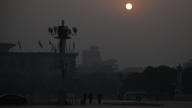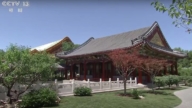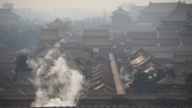【新唐人2014年09月03日讯】中国东北和中原地区多个省份正饱受旱灾之苦。河南省将近2个月没有有效降雨,遭遇了63年以来最严重的干旱。当局已经禁止农民用水浇地,农民连吃水也很困难。然而,这场天灾的背后是不是也隐藏着人为的原因呢?民众怀疑,大旱和“南水北调”工程相关。专业人士指出,“南水北调”违背自然规律,其灾害将超过三峡工程。
大陆媒体报导,河南省从今年入夏以来,降水量比往年同期减少60%,是1951年以来,历史同期最低值。平顶山市的主要水源地,白龟山水库水位,目前比死水位的97.50米还低。
河南柘城县双庙村李女士:“这整个一夏天都没下来雨。庄稼都旱。就是不让浇地了,那如果再用井里水浇地,那保不住连水都吃不到。”
旱情已经对当地农业造成严重影响。
李女士:“基本上大部分地方都绝收。有个别能缴上来,还有一点。但是有一点,收不到多少。要是如果说能有四分收成,能收到四分,就是最好的地方”
而水源丰富的湖北省,大部分地区今年主汛期的降雨也减少了20%以上。 111座小型水库和5万多口塘堰出现干涸﹔600多座水库低于死水位﹔汉江下游河段出现水位下降。丹江口水库在8月19号8点的水位只有142.77米,远远低于“南水北调”规划的蓄水位170米。
对于这一重大灾情,当局解释说,干旱是各种气候原因所致,并且声称,即使普遍认为,目前的降水趋势是“南旱北涝”,也还是要“南水北调”补缺,尤其是严重缺水的北京。
但干旱地区的村民有不同的怀疑。
李女士:“都是这样认为,是‘南水北调’。往年都没有这几年这么旱。”
村民们讨论认为,“南水北调”工程把汉江、长江和黄河的水引来引去,三峡还用水库截流,造成自然流淌的河流方向改变。水循环不畅,地下水资源流失也很严重。不仅给周边的地质和水资源环境带来严重影响,同时还造成水、云、雨的自然循环系统失衡,从而导致大旱。
旅居德国的水资源专家王维洛,曾多次发表文章说,江泽民以“给2008年北京奥运供水”为名, 2001年匆忙批准上马“南水北调”工程。每年要把10亿立方米的水引入北京,引水渠道要横穿中原700多条自然河流。工程完全打破了这些河流的自然规律,存在严重的工程隐患,甚至比三峡更大,威胁的面积更广。
北京电力工程师田先生:“从原理上就有问题,因为它并不是说,南边高,北边低,自然的流过来的。它要人为的增加很多过程,本身就破坏了自然的规律。我觉的这个可能比三峡还要糟糕。”
“南水北调”工程近期不断有问题被媒体报导出来。中线工程7月3日首次试水时,媒体爆料说,其取水源头湖北丹江口水库的水质含氮量超标,水质污染严重。官方也承认水质中氮、磷超标,却强调长途调运中会自然降解。
7月末,大陆媒体又报导称,“南水北调”工程蓄水导致汉江水位逐年减少,因水流减弱致河中鱼类7月末时还不能产卵,而往年却早已产卵完毕。位于汉江边的城市宜城因取不上水,去年以来停水3次,最长时间达48小时。
除了给环境造成迫害,北京电力工程师田先生指出,“南水北调”很可能得不偿失。
田先生:“这种非自然过程的话,耗费了很大的能量,而且浪费很多的水分。调十份水的话,最后到北京,可能连两份也到不了。”
“南水北调”工程有三条调水路线,即东线、中线和西线。其中仅东线和中线的工程造价就达5000亿人民币,比三峡工程大2.5倍。东线是从长江下游抽水,向天津、青岛和烟台方向调水﹔中线是从长江支流汉江的丹江口水库引水,向北京方向调水﹔西线是从长江上游向黄河引水。东线于2002年12月开工,2013年12月8日通水。中线于2003年12月开工,预计2014年10月通水到北京。西线目前还没有开工。
采访/李霞 编辑/周仁 后制/李勇
Henan’s Big Drought. Is This From The South–North
Water Transfer Project?
Several provinces in the Northeast and Central regions of
China are suffering from drought.
For nearly two months Henan Province, without effective
rainfall, suffered the most severe drought in 63 years.
Authorities have banned farmers from watering the land,
farmers have difficulties even with drinking water.
However, are there also human reasons behind natural
disasters?
People suspect the drought and the South–North Water
Transfer Project (SNWTP) are related.
Professionals pointed out, SNWTP is contrary to
the laws of nature;
Damages caused will be more than the Three Gorges Dam.
Mainland media reported that, since this summer, Henan
Province rainfall is 60 percent less than usual over the same
period since 1951, which is the lowest value over the same
period of history.
Pingdingshan City’s main water source, Baiguishan reservoir
water level is even lower than the dead water of 97.5 meters.
Henan Zhecheng County Shuangmiao Village Ms. Li, ”over
the entire summer it did not rain.
The crops are dry. We are not allowed to irrigate the crops.
If I use the well water, I probably cannot even
have drinking water."
Droughts have had a serious impact on local agriculture.
Ms. Li, “most places basically have no harvest. Individual
crops can be harvested a little, but there is not much.
If one place can harvest 40 percent, that’s the best."
Hubei Province is rich in water during the main flood
season this year.
But rainfall in most areas decreased by more than 20 percent.
111 small reservoirs and over 50,000 ponds dried up; over
600 reservoirs are below the dead water level;
Hanjiang River downstream water level dropped.
Danjiangkou reservoir water level is only 142.77 meters
on August 19.
This is far below the SNWTP planned water
level of 170 meters.
For this major disaster, the authorities explained that the
drought is caused by a variety of climatic reasons.
They claimed that, even if the current trend of precipitation
is “north flood south dry", it is still to “transfer water from
south to north" to fill the gap of an especially severe water
shortage in Beijing.
But the villagers in drought regions have different thoughts.
Ms. Li, " we all think it is due to the SNWTP. In previous years,
it was not as dry as in these years."
Villagers discussed and believe that, SNWTP leads the Han
River, the Yangtze River and the Yellow River water back
and forth; the Three Gorges Reservoir also caused natural
flowing rivers to change direction.
Poor circulation, and loss of groundwater resources are
also very serious.
It has a massive impact not only to the surrounding
geological environment, but also caused imbalances
to the water, clouds, rain, and natural circulation system
leading to a severe drought.
Living in Germany, water resources expert Wang Weiluo,
has published many articles about Jiang Zemin who to
“supply water to the 2008 Beijing Olympics", hastily
approved and launched the SNWTP in 2001.
It introduced one billion cubic meters of water annually to
Beijing, with diversion channels crossing more than 700
natural rivers in Central China. The project completely
broke the law of nature of these rivers;
There is a serious engineering problem, even bigger than
the Three Gorges, and the threat is to a wider area.
Beijing electrical engineer Mr. Tian, “in principle there is a
problem, because it is not that the south is high, the north is
low, and it naturally flows across. It is to artificially add a
number of processes, which undermines the law of nature.
I think this may be even worse than the Three Gorges Dam."
Problems have been reported recently about SNWTP
by the media.
When the Diversion project tested the water on July 3 for
the first time, the media exposed that the water source
from Danjiangkou Reservoir exceeded the nitrogen content,
and was seriously polluted.
The official also acknowledged that water quality for
nitrogen and phosphorus exceeded the standards.
However he stressed that it would naturally degrade
through long-distance transportation.
In late July, the mainland media also reported that SNWTP
led to a decrease in the Han River water level,.
Due to the reduced water flow the fish were unable to
spawn by end of July, while in previous years they had
finished spawning.
Yicheng city located by the Han River was without water
three times since last year, the longest time was 48 hours.
In addition to the environmental damages, Beijing electrical
engineer Mr. Tian pointed out that the drain from SNWTP is
likely to outweigh the benefits.
Mr. Tian, “this unnatural process takes a lot of energy and
wastes a lot of water.
Introduce ten percent water, and finally arriving in Beijing,
maybe even not two percent will get there."
SNWTP has three water diversion routes, namely the east,
middle and west line.
Of which the middle and east lines cost amounted to 500
billion yuan, 2.5 times larger than the Three Gorges Project.
The East line is pumped from the Yangtze River to Tianjin,
Qingdao and Yantai direction.
The Midline is from Danjiangkou Reservoir as a division of
Yangtze tributary the Han River, in Beijing’s direction;
The West line is from the upper Yangtze River to the Yellow
River water diversion.
The East line started in December 2002, until December 8,
2013 the water went through.
The Midline started in December 2003, is expected to have
water through in October 2014.
The West Line has not been started yet.
Interview/LiXia Edit/ZhouRen Post-Production/LiYong




























